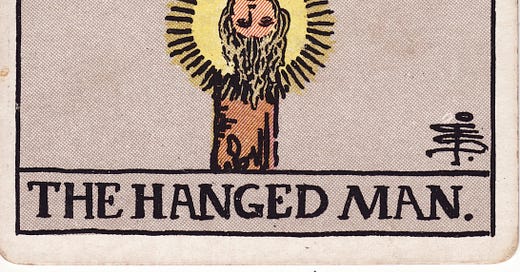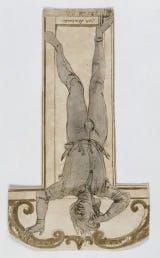Remember when you were a kid, hanging upside down on the monkey bars at the playground? Do you remember how brave, and also disorienting it felt, and also exhilirating to see the world upside down? It felt dangerous. One slip and you fall on your head.
This card is often and aptly interpreted with the themes of sacrifice and acceptance, but I’ve begun to see it a little differently. If we see the Major Arcana as a tool to understand human development, and personal transformation, each card shows us a step along the way, And while sacrifice and acceptance may be part of the process, so too is turning the world upside down. Note the halo around our figure’s head. The turning his world upside down results in his aha moment. What if we were to take those ideas we hold “most true” and consider the opposite? This is risk taking par excellence. When we risk our ideas, we are open to change. The Major Arcana might be described as twenty-two steps through the process of change.
I’ve always been a risk taker, which perhaps means I enjoy being upside down. There are tons of psychological theories about risk-taking, particularly regarding adolescents, as much of our risk taking behavior seems to be tamed as we move into adulthood (at least for some of us!). Witnessing university students these past few weeks, risking their enrollment and personal freedom to protest the actions of statesmen, bankers, and administrators, I see a risk to unknown outcome ratio which is quite high. Pushing boundaries and limits is the essence of taking risks, as is also acting upon our beliefs and not being certain of the outcome. Consider a time you jumped in with both feet, without knowing what might happen as a result of the jump. In some ways risk taking can be viewed as simply as the difference between two kinds of behavior, one who jumps off the dock into the lake and the person who gently lowers herself in.
Back to our Hanged Man. The halo comes from his shift in perspective, his ability to see his situation differently than he did upright. A colleague of mine said the other day that he didn’t get up there by himself, and also reminded me that the original name for the Hanged Man in 15th century European tarot, was “The Traitor” (Il Traditore).
The tarot Hanged Man is a representation of the Pitture Infamanti, “shame paintings”, that were painted in public areas of Italian cities during the renaissance. Traitors who skipped town and couldn’t be executed in person were hung in effigy as paintings on the walls of public buildings. These images didn’t survive long as they were exposed to the weather. All we have are a few preliminary chalk drawings by Andrea del Sarto, and an ink drawing in a book by Filippino Lippi. Both were prominent Florentine artists of the late fifteenth and early sixteenth century.
TarotHeritage.com
I bring this up to remind us that taking risks which support our beliefs and values, also may lead to paying the price of scorn, disdain, and in some cases our very lives. So in thinking again of more traditional interpretations of The Hanged Man, I’m brought back to the ideas of sacrifice and acceptance. Sacrificing safety for our beliefs and accepting unknown outcomes, as a result of stepping out of the comfort zone of seeing the world right side up, which isn’t always actually “right.” The Hanged Man is all about being willing to hang upside down on the monkey bars, knowing the potential danger, and doing it any way.
xo Hanna






